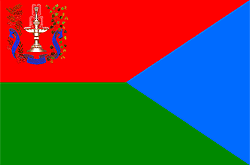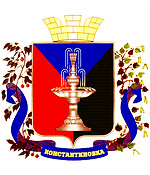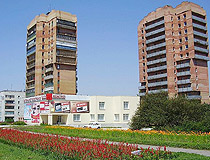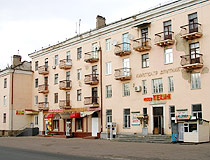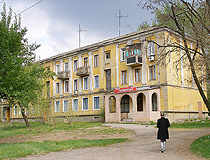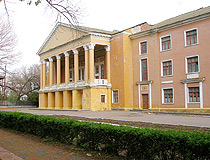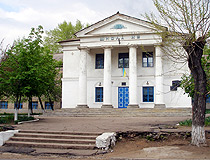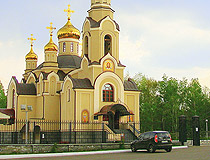History of Kostiantynivka
Foundation of Kostiantynivka
People began to settle on the banks of the Kryvyi Torets River from ancient times, at least 100-150 thousand years ago. Favorable climate, rivers and steppes, rich in fish and animals, attracted people here. Different ethnic groups replaced each other, roaming these steppes.
In 1812, on the territory of today’s Kostiantynivka, on the land bought from the Bakhmut merchant Chetverikov, the landowner Panteleimon Nomikosov founded the village of Santurinovka, in which 20 families of serfs brought from the Kursk Governorate were originally settled. For some reason, he named the village after the Greek island of Santorini in the Aegean Sea. Santurinovka was located on the territory of the current historical center of Kostiantynivka.
In the middle of the 19th century, on the land inherited by the son of Panteleimon Nomikosov, the village of Konstantinovka was founded, named after its founder and owner - Konstantin (Kostiantyn in Ukrainian) Nomikosov. In 1859, 29 people lived in Konstantinovka, 280 - in Santurinovka, and 456 - in Novoselovka (an old village, which is part of Kostiantynivka now).
Kostiantynivka in the late 19th century
In the 1870s-1880s, an important prerequisite for the emergence of the future city was that the Kursk-Kharkov-Azov railway was laid through this area and the Konstantinovka railway station was built. In 1880, it was connected to the Kharkov-Sevastopol railway. At the end of the 19th - beginning of the 20th centuries, conditions were formed for the development of industry here.
More Historical Facts…
In 1896-1898, “Donetsk Glass Factories in Santurinovka”, a Belgian joint-stock company, built glass, bottle and chemical plants here. Its products under the trademark “Two Bells” were awarded 8 gold medals at exhibitions in Kiev, Rostov-on-Don, Kazan, St. Petersburg, Yekaterinoslav, Odessa. Another large enterprise in the production of glass products was a mirror factory owned by “The Anonymous Society of Mirror Factories in the South of Russia”, built in 1899.
Another Belgian joint-stock company called “The Iron-Rolling Factories in Konstantinovka (Donets)” organized manufacturing of metal products. The production of refractory and ceramic goods was widely developed here too.
The village of Konstantinovka and the Konstantinovka station settlement became a single settlement. According to the 1897 census, about 3,100 people lived in it. The number of residents continued to grow rapidly and by 1917 amounted to more than 10 thousand. This was also due to refugees coming from the frontline regions of the Russian Empire during the First World War.
Kostiantynivka in the first half of the 20th century
In 1918-1919, during the Civil War that followed the collapse of the Russian Empire, the power in Konstantinovka changed dozens of times. From April to November 1918, it was under the control of the army of the Ukrainian People’s Republic supported by Germany. Then the city changed hands many times between the Bolshevik Red Army and different troops of the anti-Bolshevik White movement.
In 1925, Konstantinovka was given the status of an urban-type settlement. According to the 1926 census, 25,303 people lived in it. In 1931, the construction of the first tram line began (from the railway station to the center of the city). In 1932, Konstantinovka became a town. In the second half of the 1920s-1930s, local industry was largely modernized and new enterprises were built.
In 1937, for the first time in the USSR, bottles for the so-called “Soviet champagne”, which could withstand pressure up to 17 atmospheres, began to be produced here. In the same year, the first high-strength glass workshop in the USSR began its operation here. From 1937 to 1947, the towers of the Moscow Kremlin were crowned with ruby glass stars made in Konstantinovka. In 1939, about 140 million different bottles were produced here. The population of the city was about 96 thousand people.
For the 1939-40 New York World’s Fair, crystal bowls of the fountain were made at the factory in Konstantinovka. A description of this fountain has been preserved. It was a shallow bowl, 2.25 meters in diameter, made of a solid fragment of thick crystal, resting on a monumental colored leg. In the center of a large bowl stood another one, smaller in size, with a sheaf of crystal ears, from which water flowed into the small bowl and, having filled it, overflowed into the large one. The image of this fountain occupies the central place on the coat of arms of today’s Kostiantynivka.
Kostiantynivka during and after the Second World War
On October 28, 1941, during World War II, the German army occupied Konstantinovka. On September 6, 1943, the Red Army regained control of it. Subsequently, this date began to be celebrated as the City Day of Konstantinovka. In 1945, the workers of the local glass factory “Avtosteklo” completed an urgent order for the front - 200 powerful reflectors for searchlights, which were used during the Battle of the Seelow Heights, part of the Soviet Berlin Strategic Offensive Operation.
During the 22 months of German occupation of Konstantinovka, about 15,000 people were killed, about 1,500 people were forcibly taken to work in Germany. More than 8,000 residents of the city, drafted into the ranks of the Red Army, died in battles. In 1944, there were about 45,000 residents in Konstantinovka.
By 1949, its enterprises were completely restored. Prisoners of war from Germany and Romania were also involved in this work. Over time, “Avtosteklo” became the largest factory in Konstantinovka, specializing in the production of glass for the military, automotive and aviation industries, mirror, high-strength and display glass. The factory also carried out special orders: a sarcophagus for the mausoleum of Vladimir Lenin (1960), portholes and tempered (cold-resistant) glass for the world’s first nuclear icebreaker “Lenin” (1960).
In the 1970s-1980s, the products of the glass factories of Konstantinovka were exported to about 30 countries. In the 1980s, about 170 million bottles for champagne were produced annually here - 90% of the entire production in this industry in the USSR.
Another important industry in Konstantinovka was metallurgy, represented by large non-ferrous and ferrous metallurgy enterprises, producing high-quality zinc, steel for the Volga and Gorky automobile plants (VAZ, GAZ).
At first, the city was built up mainly with two-three and five-story buildings, brick or panel. In the late 1970s and 1980s, nine-story panel buildings became widespread in Konstantinovka. By the end of the 1980s, there were 11 large enterprises of all-Union significance in Konstantinovka. In 1989, the population of the city numbered about 108 thousand people.
Kostiantynivka in independent Ukraine
After 1991, when Ukraine’s independence was proclaimed, industry continued to be the backbone of the local economy, although the number of enterprises and the people employed in them began to decrease rapidly. This was due to the cut of long established economic ties between enterprises located in different countries of the former Soviet Union, a significant decrease in defense orders and the transition to a market economy in general.
On December 15, 2000, the current coat of arms of Kostiantynivka was approved by the decision of the city council. As of January 1, 2009, 7,170 people were employed at local industrial enterprises. From 1991 to 2021, the population of Kostiantynivka decreased by about 35%.
On April 16, 2014, the Kostiantynivka city council decided to support the holding of a referendum on the territory of Donetsk Oblast on the establishment of the Donetsk People’s Republic on May 11, 2014. On April 28, 2014, the city council and the police department were captured by armed separatists of the DPR.
On the night of May 4, 2014, the Ukrainian army began an anti-terrorist operation in the city. In Kostiantynivka, an assault force was landed from two helicopters. There was a firefight near the TV tower. However, the main forces of the Ukrainian army were focused on regaining control over the city of Sloviansk, so Kostiantynivka remained under the control of the DPR.
On May 25, 2014, residents of Kostiantynivka were unable to take part in the Ukrainian presidential elections. As in a number of other cities in Donetsk Oblast, representatives of the DPR did not allow the election process to be organized in Kostiantynivka.
On July 5, 2014, the confrontation in Sloviansk between the forces of the Ukrainian army and the DPR ended with the retreat of the latter from Sloviansk, nearby Kramatorsk, Bakhmut, and Kostiantynivka. The Ukrainian flag was again hoisted over the building of the city administration.
Since only dozens of people took part in the active confrontation on both sides on the territory of Kostiantynivka, there were no large human losses, several people died and were injured.
In 2022-2023, during the ongoing Russian invasion of Ukraine, Kostiantynivka was hit by a series of missile attacks that led to the destruction of some infrastructure facilities. If nearby Bakhmut is captured by Russian forces, then Kostiantynivka will be at the very front line and probably become one of the next battlefields.
Pictures of Kostyantynivka
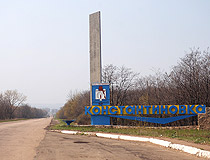
Kostyantynivka entrance sign
Author: Valeriy Dudush
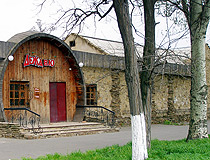
Bar Deja Vu in Kostyantynivka
Author: Sotnikov
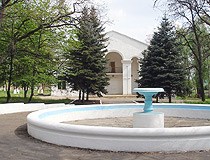
In one of the parks of Kostyantynivka
Author: Sotnikov
Kostyantynivka - Features
Kostyantynivka is considered the center of the Ukrainian glass industry. There are several enterprises and the only glass research institute in the country dealing with scientific and technical support and standardization in the glass industry of Ukraine.
On the coat of arms of Kostyantynivka you can see an image of a crystal fountain, which was made at a local glass factory for the Soviet pavilion at the 1939-40 New York World’s Fair. The fountain symbolizes the developed glass industry of this city, which in the past supplied the entire USSR and a number of other countries with glass products.
The city also has enterprises of non-ferrous metallurgy and chemical industries. The railway station Kostyantynivka is a major railway junction. Buses are the main public transport. Trams stopped running in Kostyantynivka in 2016.
The City Day in Kostyantynivka is celebrated on the 2nd Saturday of September in honor of the liberation of the city from the Germans on September 6, 1943. According to the 2001 census, 20.98% reported Ukrainian as their mother tongue, 78.06% Russian.
Main Attractions of Kostyantynivka
Local History Museum of Kostyantynivka. The exhibits of this museum tell the story of the founding of Kostyantynivka, historical facts about the construction and work of the first factories. There are three exposition halls: “Ukrainian Svetlitsa”, the hall of symbols, the hall of the history of the development of the Kostyantynivka district for 70 years. Trudova Street, 388.
Kleban Byk - a regional landscape park located on the banks of the Kleban-Bykske Reservoir, a few kilometers south of Kostyantynivka. The territory of the park is characterized not only by unique natural complexes and objects, but also by special recreational conditions, which are determined by a variety of picturesque landscapes. The Kleban-Byk outcrop is of particular interest. It is a geological natural monument of national importance located on the left slope of the reservoir.
History Museum of Oleksandro-Kalynove Village. This museum, located in the village of Oleksandro-Kalynove, about 10 southwest of Kostyantynivka, consists of three main parts: a Ukrainian hut furnished in the style of the 18th-19th centuries; a hall in which exhibits are stored, some of which are dedicated to the Second World War; outdoor exposition, which presents an old tractor, tools, sculptures, and the IS-3 tank. The museum exposition presents examples of carpentry and blacksmith tools, as well as things of peasant life. The museum is proud of its unique collection of scales.
Krovets’ka Balka - geological monument of nature of national importance located on the southeastern outskirts of the village of Ivanopillya, about 7 km southeast of Kostyantynivka. Here you can see the fossil remains of coniferous tree trunks at different stages of their transformation into coal.
Chalk Mountain in Bilokuz’mynivka - a picturesque geological monument of nature located about 15 km north of Kostyantynivka. The age of this chalk mountain is about 90 million years. It consists of sediments from the last period of the Mesozoic era, which formed in clear warm sea waters from small marine organisms with a calcareous skeleton.
Among the chalk gravel, flint is often found. The chalk outcrop rises to a height of more than 25 meters. The outcrop and rocks are completely devoid of vegetation. Nearby, a site of prehistoric people with a workshop for processing flint mined in this mountain was discovered.


